
The Impact of Insulation on Your Roof: Energy Efficiency Tips
Roof insulation is a material or system that is installed in the attic or roof space of a building to regulate the temperature inside the building. Your roof is like a giant umbrella for your home, shielding it from the sun’s heat in summer and preventing heat loss in winter. But without proper insulation, this umbrella becomes porous, allowing energy to escape and driving up your energy bills.
Proper roof insulation is like adding a thick layer of cozy comfort to your home. It acts as a barrier, trapping heat indoors during winter and preventing hot air from entering during summer. Think of it as an invisible shield that protects your home’s energy efficiency and saves you money in the long run.
Purpose of Roof Insulation
The primary purpose of roof insulation is to:
Reduce heat loss in the winter:
In the winter, roof insulation prevents warm air from escaping from the building, keeping the interior warm and comfortable. This reduces the need for heating, leading to lower energy bills.
Minimize heat gain in the summer:
During the summer, roof insulation prevents the heat from the sun from radiating into the building, keeping the interior cool and comfortable. This reduces the reliance on air conditioning and saves energy.
Improve indoor air quality:
Proper roof insulation can help to control moisture levels in the attic, preventing condensation and mold growth. This contributes to better indoor air quality and reduces the risk of respiratory problems.
Extend the lifespan of the roof:
By reducing temperature fluctuations and moisture buildup, roof insulation can help to prolong the lifespan of the roof structure and roofing materials.
Types of Roof Insulation
There are various types of roof insulation available, each with its own properties and applications:
Fiberglass batts:
These are the most common types of roof insulation, consisting of glass fibers that are spun into mats or batts. Fiberglass is relatively inexpensive and easy to install, making it a popular choice for DIY projects.
Loose-fill insulation:
This type of insulation consists of loose fibers or pellets that are blown into attic spaces or between rafters. Loose-fill insulation can be more challenging to install than batts but offers excellent insulation performance.
Spray foam insulation:
This type of insulation is applied as a liquid foam that expands and fills any gaps or crevices. Spray foam insulation provides excellent air sealing and can be used in irregularly shaped spaces.
Rigid foam boards:
These are pre-formed boards made from polyurethane or polyisocyanurate foam. Rigid foam boards offer high insulation values and are often used in new construction or when replacing old insulation.
The choice of roof insulation depends on factors such as the climate, budget, and type of roof. Consulting a professional contractor can help determine the most suitable insulation type for your specific needs.
Benefits of Roof Insulation
Proper roof insulation offers numerous benefits, including:
Reduced energy costs:
Efficient roof insulation can significantly lower energy bills by minimizing heat loss and gain, reducing the need for heating and cooling.
Enhanced comfort:
A well-insulated home maintains a consistent temperature throughout the year, eliminating uncomfortable drafts and hot spots, and ensuring a more comfortable living environment.
Improved indoor air quality:
Insulation helps to control moisture levels and prevent mold growth, contributing to better indoor air quality and reducing the risk of respiratory issues.
Extended roof lifespan:
Proper insulation protects the roof structure from temperature extremes and moisture damage, prolonging its lifespan and reducing the need for premature roof replacement.
Environmental protection:
By reducing energy consumption and minimizing greenhouse gas emissions, roof insulation contributes to a more sustainable environment.
Tips for Energy-Efficient Roof Insulation
To maximize the energy efficiency of your roof insulation and reap the full benefits, consider these tips:
Ensure adequate R-value:
The R-value is a measure of insulation resistance. The higher the R-value, the better the insulation performance. Check the recommended R-value for your climate zone and ensure your existing insulation meets or exceeds that requirement.
Seal air leaks:
Air leaks around vents, chimneys, and other openings can significantly reduce insulation effectiveness. Use weatherstripping, caulk, or specialized sealant to seal these leaks and prevent heat loss or gain.
Maintain proper ventilation:
While insulation is crucial, proper ventilation is equally important to prevent moisture buildup and condensation. Ensure adequate attic ventilation to maintain a healthy indoor environment.
Upgrade old insulation:
If your existing insulation is old, damaged, or inadequate, consider upgrading to a more efficient material like spray foam or rigid foam boards. These materials offer better R-values and can seal air leaks more effectively.
Seek professional help:
If you’re unsure about the type of insulation to use, the extent of air leaks, or the overall condition of your roof, consult a professional contractor. They can provide expert guidance and ensure proper installation for optimal performance.
Final Thoughts
Roof insulation plays a vital role in your home’s energy efficiency and comfort. By understanding the importance of insulation, choosing the right type for your needs, and combining it with other energy-saving measures, you can transform your home into a haven of comfort and sustainability.
Remember, you have the power to make a difference in your home’s energy consumption and overall well-being. Embrace the benefits of proper roof insulation and embark on a journey towards lower energy bills, a more comfortable home, and a greener future.